What I have done in this section is to find the period and the absolute magnitude (M) of different Cepheids (515) and I have put it in an excel, where I have been able to obtain a graph and an equation that allows me to calculate the absolute magnitude (M) of any Cepheid from period.
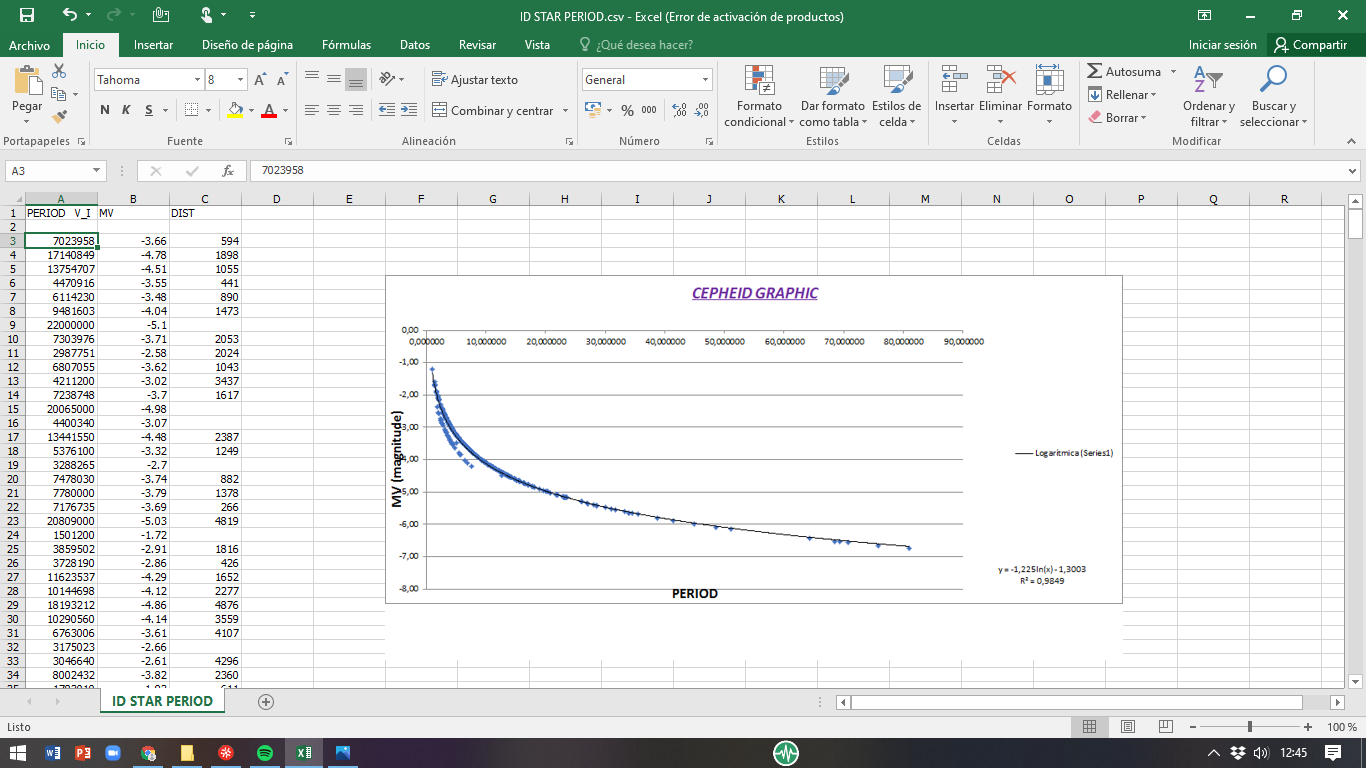
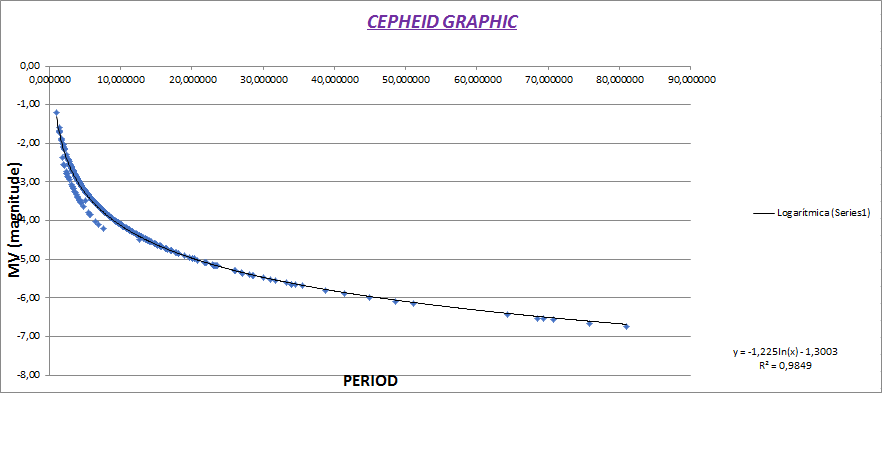
Then I have calculated the absolute magnitude (M), with the excel equation and with the general formula of the ESO/ESA book, of VY Canis Majoris found in the constellation of Can Major.
Period of VY Canis Majoris Cepheid: 1,6-1h= 1,600-2,200 days
General formula of the ESO/ ESA book:
M=-2,78 log(P) -1,35
M= -2,78 log(1,600) -1,35
M= -1,917
M= -2,78 log(P) -1,35
M= -2,78 log(2,200) -1,35
M= -2, 301
M= -1,917-(-2,301)
Excel equation:
y= M (magnitude)
x= P (period)
y= -1,225In(x)-1,3003
M= -1,225In(p)-1,3003
M= -1,255In(1,600)-1,3003
M= -1,890
M= -1,255In(P)-1,3003
M= -1,255In(2,200)-1,3003
M= -2,289
M= -1,890-(-2,289)

Here's another cepheid graphic, which shows the relation of the period and the Mv of some cepheids from this scientific article: Calibrating the Galactic Cepheid Period–Luminosity Relation from the Maximum-likelihood Technique
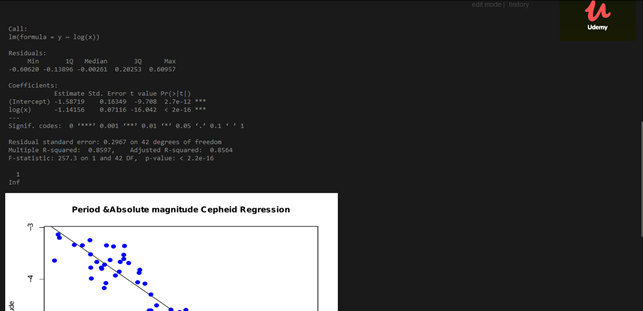



As you can see, not all Cepheids correspond to the line, but some stand out. This is because there are two types of Cepheids:
- Type I (Classical) Cepheids.
- Type II (W Vigins) Cepheids.The main difference between these types of cepheids is that Classical cepheids have more luminosity than the ones that are types II.
VY Canis Majoris is located about 5,000 light years away, near the field of the young open cluster NGC 2362.
Historical records of its variability show that at the beginning of the 19th century its average brightness was brighter than it is today reaching magnitude V= 6.5.
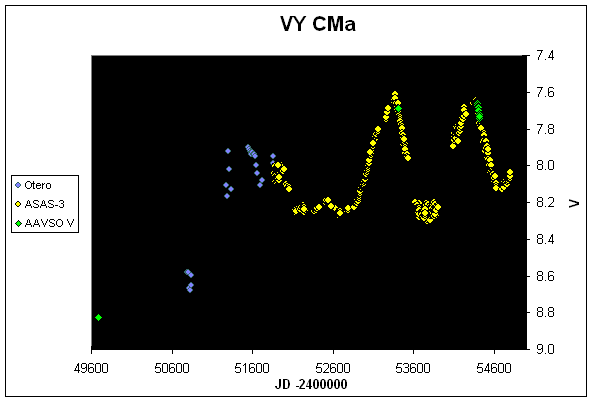
Recent light curve of VY CMa with photometric data from ASAS-3 and AAVSO and visual data from Otero.
Currently the star varies between magnitudes 7.6 and 9 ( see in the photo 1), but it becomes as faint as V= 9.6 ( see in the photo 2).
It is not surprising that, in the case of a red supergiant, it varies, but VY CMa is not just any red supergiant.
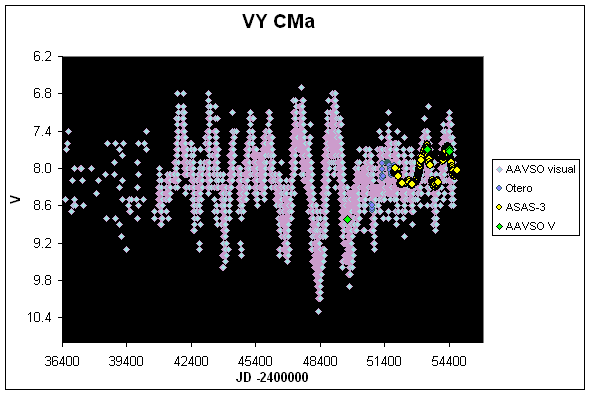
For a long time it was believed that different points of light detected around the central source were components of a multiple system, but with larger telescopes and especially because of the variability of these components, it became clear that they were condensations of gas that moved and changed
their shape. shine around the star. These are ejections of matter that have taken place at different times, which are not symmetrical and form "lumps". This occurs because the variable is in an advanced evolutionary
phase (moving to the left in the HR diagram from the area of the red supergiants towards the area of the yellow supergiants) in which the rate of mass loss is very large, and even more so since it is a massive star.
-How are its variations explained?
It is probably a long-period variable SRc or Lc whose variations are hidden under the dense gas layer. The gas nebula also varies by scattering light from the central source so that can affect the light curve as well.
The GCVS classifies it as unique in its class and with a spectral type M5eIbp (C6.3), which denotes the presenceof carbon, although more up-to-date measurements place it between the spectral types M2.5I and M5I, depending on the lines used. for determination.
The luminosity of the star has been the subject of debate recently. It was classified as a hypergiantat thepossiblelimit of luminosity and 2800 times the size of the solar (Humphreys et al., 2005),but subsequent measurements seem to indicate that it is not as cold as previously thought (3600 K instead of 2900) and therefore its size would be about 600 solar radii (Massey et al., 2006)
and we would be facing a normal supergiant of about 15 solar masses.
For a long time it was believed that different points of light detected around the central source werecomponents of a multiple system, but with larger telescopes and especially because of the variability of these components, it became clear that they were condensations of gas that moved and changed their shape. shine around the star. These are ejections of matter that have taken place at different times, which are not symmetrical and form "lumps". This occurs because the variable is in an advanced evolutionary phase (moving to the left in the HR diagram from the area of the red supergiants towards the area of theyellow supergiants) in which the rate of mass loss is very large, and even more so since it is a massive star.